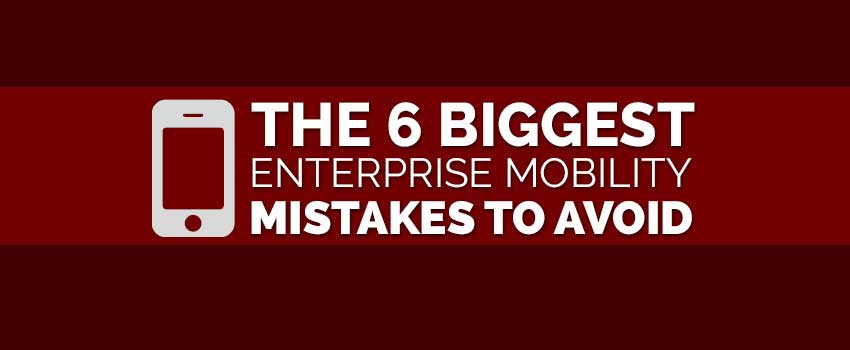18 July 2016
The Six Biggest Enterprise Mobility Mistakes To Avoid
Businesses are moving forward in key areas with their enterprise mobility strategies, but all too often development mistakes, like the ones below, can risk project chaos.
Many businesses like yours want to take their processes and business functions mobile. What many companies fail to understand is the complexity involved with developing a mobile app and don’t realize their mistake until they’re in the middle. They then face spending development time and resources just to get the project back on track where it should have been in the first place. You’ll want to make sure your team is experienced in all aspects of a mobile app project like this.

How can you be sure that your enterprise mobility project won’t make these same mistakes? We’ve collected 6 things you’ll need to know.
1) Not starting with an MVP
It’s tempting to want to solve all of the problems your business is facing. A mobile app can seem like a skeleton key that unlocks all of the locked doors in your company. The danger here is taking on too much, too quickly. If you try a kitchen sink solution, you run the risk of overdeveloping the app and creating features that aren’t even used.
When it comes to developing a solution for a business, they need to think lean like a start-up and only focus on the most critical tasks first, then build-out.
Looking to improve your company’s efficiency with your own enterprise mobile app? See what our award-winning team can do for you and contact us for a free consultation today.
2) Build for the right environment
iOS, Android, Windows, Web – you may be tempted to just look around the office and go with whichever is the most popular platform. But you have to think larger than that. What about server architecture? How will data get to and from the app? What kind of information needs to be pulled in by the various departments. What about gathering data from other areas of the business?
A mobile app is more than just what’s sitting on the device. From the server setup to API, all of this needs to be thought through. When it comes to enterprise, the app on the device is just the tip of the iceberg.
3) Thinking Web and Mobile development are the same
Many development teams think that their in-house development departments can handle a mobile app. It can be very tempting to pull from that resource given their expertise and experience inside the company – but the lack of experience developing an enterprise mobility solution can cause delays and ballooned costs.
Hybrid mobile applications are closing the gap between web and mobile development, but it’s important to take an honest evaluation of your company’s talent and really ensure that you understand their strengths and weaknesses. Ignoring your team’s limitations and thinking “code is code” is only going to cause problems.
4) Ignoring the user experience
The design may seem like an after-thought line item; just making sure that the colors are clear and the text is readable. One of the main goals of an enterprise mobile app is efficiency. Understanding the needs and wants of the users of the app – the employees – is crucial to making sure that it’s as efficient as possible.
An easy-to-use experience frees the user up to focus on tasks and not, “how do I use this thing?”. Worse, it could cause the user to abandon the app entirely and go back to what was working before. Enhance the employee’s experience, and you’ll enhance their productivity.
5) No plan to scale or grow features
The importance of starting with an MVP is the ability to scale in the direction of need. Anticipating every problem and every solution around your app isn’t possible. You need a plan to grow and scale as the opportunity arises. Something as simple as user growth can increase the application and server complexity to handle millions of requests.
Rolling out features as needed in a logical, methodical manner keeps costs down and the overall project efficient. You can’t build it all at once, so be sure you have the budget and bandwidth set up to regularly roll out features and bug fixes as they develop. Plus, as the enterprise changes, the app will need to follow suit.
6) Keeping the entire application stack secure
Your app is going to handle critical and confidential business information and data. You can’t take any chances with the integrity and security of your enterprise app. From the concept stage, it should be designed with key security features like 2 step authentication, SSL, data encryption, IP restrictions, etc. Ignoring this to roll in later isn’t an option when compared to the cost of a data loss or breach.
Watching an enterprise mobility project fail can be difficult to deal with, but don’t get discouraged from embracing the power it contains. Taking a hard look at your company and seeing the opportunities can unlock more efficient employees and a more streamlined business.
Think we missed out on something or have a question? please feel free to comment below.






